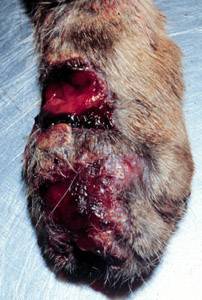Sporotrichosis is a environmental or zoonotic disease caused by the fungus Sporothrix schenckii and is commonly found in soil, wood, and decaying vegetation. The fungus is a dimorphic forming yeast in tissues or culture at 37oC, but growing as a filamentous mould in the environment at room temperature. Most cases of sporotrichosis are acquired from the environment as a result of contact between broken skin and fungal spores and are most common in persons that work with vegetation such as forestry workers, horticulturists, gardeners and florists. As a consequence, the disease is commonly referred to as “Rose Gardener’s Disease”. Cats can similarly acquire infection from the environment via wound contamination or penetrating foreign bodies.
 The most common form of the disease in cats and humans is a lymphocutaneous form that first appears at the site of inoculation leading to formation of papules. The papules develop into pustules that slowly expand along the draining lymph system, forming swollen cutaneous nodules that may become necrotic, ulcerate, and produce a gray or yellowish pustular exudate. Subclinical infections are possible. Disseminated and pulmonary sporotrichosis are serious, life-threatening diseases, but are much less common.
The most common form of the disease in cats and humans is a lymphocutaneous form that first appears at the site of inoculation leading to formation of papules. The papules develop into pustules that slowly expand along the draining lymph system, forming swollen cutaneous nodules that may become necrotic, ulcerate, and produce a gray or yellowish pustular exudate. Subclinical infections are possible. Disseminated and pulmonary sporotrichosis are serious, life-threatening diseases, but are much less common.Sporotrichosis is also an important zoonotic disease and transmission from infected cats to humans is possible due to the high number of infectious organisms found in open draining wounds. Cats can also harbor the fungus in the mouth, nasal cavity, and nail beds facilitating transmission via bites or scratches.
This study describes the epidemiological, clinical, and mycological aspects of feline sporotrichosis in 147 infected cats identified between 1998 and 2005 in Rio de Janeiro, Brazil. A large number of cases of infection in cats, dogs and humans have occurred in this area, representing the first zoonotic epidemic of this mycosis. Treatment of infected cats typically is carried out by oral administration of anti-fungal agents such as itraconazole or ketoconazole. Factors in treatment abandonment included low income of owners, the difficulty in transporting the cats to clinics for follow-up, and the difficulty in administrating oral medications to cats. The most common reason for treatment abandonment was the misperception by owners of lesion healing, often leading to recurrence of the disease. Treatment abandonment may represent an obstacle in control of this disease and possibly contributes to the Rio de Janeiro epidemic. Efforts on adherence to the protocol in the beginning of treatment, but especially after the skin lesions have improved, seems to be an important measure for better compliance and increased cure rates. [GO]
See also: Reis ÉG, Gremião IDF, Kitada AAB, et al. Potassium iodide capsule treatment of feline sporotrichosis. J Feline Med Surg. 2012; 14: 399-404.
More on cat health:
Winn Feline Foundation Library
Find us on Facebook
Follow us on Twitter
Join us on Google+
No comments:
Post a Comment